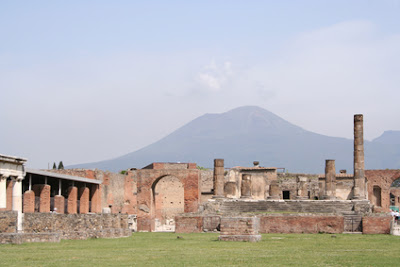Luke tells of the Apostle Paul's stay in Corinth
Timeline.
146 BC - Corinth
44 BC - Julius Caesar re-founded Corinth Corinth Egypt Greece Syria Judea . Corinth Roman Empire .
50 AD - Paul arrived in Corinth
There was a famine there in
Paul's time and some scholars think this is what Paul is referring to by
"this present distress" in 1 Corinthians 7:26.
51-52 AD - Paul was still in
Corinth
Paul's trial before Gallio.
52 AD - Paul ended his stay
in Corinth
52 and 57 AD - Paul's trial
before Felix.
Paul left for Rome
55 AD - Paul wrote the
letter we now know as First Corinthians.
The following photo is an artist's idea of what ancient Corinth looked like. Note the huge mountain, the Acrocorinth, towering over the city. (Attribution: By unknown artist (The American Cyclopedia v. 5, 1879, p. 353) [Public domain], via Wikimedia Commons.)
The following photo is how the Acrocorinth looks today. The photo is taken from the ruins of the Temple of Apollo. (Attribution: By Kathryn McDonnell [CC-BY-2.0 (http://creativecommons.org/licenses/by/2.0)], via Wikimedia Commons)
Below are ruins in the large harbor of Cenchrea. Paul mentions Cenchrea in Romans 16. (Attribution: By Heinz Schmitz (Own work (eigenes Bild)) [CC-BY-SA-2.5 (http://creativecommons.org/licenses/by-sa/2.5)], via Wikimedia Commons)
The following photo shows the Isthmus of Corinth. (See the narrowest strip of land.) Today there is a canal (built in the 1800) so boats can sail between the Lechaeon harbor on the west and the Cenchrea harbor in the east. The canal is 4 miles long. It is too narrow for modern ships. (Photo Attribution: By Jesse Allen [Public domain], via Wikimedia Commons)
The following photo shows the canal today. (Attribution: By Jean Housen (Own work) [CC-BY-SA-3.0 (http://creativecommons.org/licenses/by-sa/3.0)], via Wikimedia Commons)
Back in early Christian times, there was a marble pathway across the Isthmus, and boats were hauled onto rollers and pulled across by slaves from one harbor to the other. The alternative was to sail a dangerous sea journey which lasted for 200 miles. The road was marble. This was called the "diolkos."
The following photo shows the ruins of the diolkos. (Attribution: By Heinz Schmitz (http://outis.info/archaia_f/1411/isthmos.html) [CC-BY-SA-2.5 (http://creativecommons.org/licenses/by-sa/2.5)], via Wikimedia Commons)
The following photo shows the ruins of the diolkos at the Lechaeon harbor on the west. . (Attribution: By Dan Diffendale [CC-BY-SA-2.0 (http://creativecommons.org/licenses/by-sa/2.0)], via Wikimedia Commons)





















